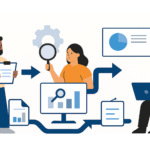Streamline Your Results Reporting: Essential Tips for MEAL Professionals
As reporting season approaches, many Monitoring, Evaluation, Accountability, and Learning (MEAL) professionals are preparing to submit results reports for their projects. Whether you’re reporting to donors like Global Affairs Canada (GAC) or other stakeholders, clarity and precision are critical. Drawing on GAC’s Results-Based Management Checklist for Reviewing Results Reports, this post provides actionable tips to help you streamline your reporting process, ensure accuracy, and communicate your project’s impact effectively.
Why Results Reporting Matters
Results reporting isn’t just an obligation—it’s an opportunity to showcase your project’s impact, learn from challenges, and refine your approach. A strong report demonstrates accountability and supports evidence-based decision-making, helping funders and stakeholders see the value of their investment.
Practical Tips for Effective Results Reporting
1. Anchor Your Report in the Logic Model
- Include the latest version of your approved Logic Model (LM) and Performance Measurement Framework (PMF) (or equivalent) in the body of the report or as an annex.
- Organize the results section by outcomes, not activities. Clearly state the expected outcomes against which you are reporting. Structuring your report around outcomes ensures a clear focus on the project’s results and impact.
Example: Report on how outputs like the delivery of 200 community health workshops led to increased awareness of maternal health practices among 80% of participants (outcome), contributing to a reduction in maternal mortality rates in the target region (ultimate outcome).
2. Present Data with Clarity
- Provide actual data for each indicator as per the schedule in your PMF. Disaggregate data by gender, age, location, or other relevant categories.
- Use comparisons to baselines and targets to highlight progress. Including proportional context, like “70 out of 100 girls,” can provide more clarity and helps stakeholders better understand the scale and significance of your results.
Example: “70% of girls in the program completed secondary school compared to 50% at baseline, achieving 95% of the project’s target.”
3. Tell the Story Behind the Numbers
- Provide a narrative assessment of progress using both qualitative and quantitative data.
- Highlight how outcomes are experienced differently by women, men, and other social groups.
- Address progress made on outcomes during the reporting period, contextual factors affecting performance (e.g., political shifts or natural disasters), and variances between expected and actual results, including any unexpected outcomes.
Example: “The program aimed to increase school attendance among youth in rural areas. By the end of the reporting period, attendance rates for girls had increased by 25% compared to baseline data, and by 20% for boys, surpassing the overall 20% target. Girls highlighted that improved access to school supplies and mentoring programs helped them feel more supported in their studies, while boys reported greater engagement through new extracurricular activities. However, flooding during the rainy season temporarily disrupted school access. To address this, temporary learning centers were set up, providing a safe learning environment and ensuring that education continued for all students.”
4. Reflect and Adapt
- Document challenges and lessons learned. What worked? What didn’t? What corrective actions were taken or are proposed?
- Include rationales for changes to your Theory of Change, LM, or PMF based on these lessons.
- Demonstrating agility and a commitment to continuous improvement shows donors how lessons are shaping future plans.
Example: “In a maternal health project, a delay in distributing medical supplies affected prenatal care outreach. To address this, local clinics partnered with mobile health units, which helped reach over 500 expectant mothers within the reporting period. Moving forward, the team will establish contingency plans to mitigate supply chain disruptions.”
Practical Reporting Tips for MEAL Staff
- Double-Check Alignment: Ensure your report aligns with donor expectations and guidelines, such as GAC’s RBM standards.
- Leverage Tools: Use templates like GAC’s Outcome Reporting Worksheet to standardize data presentation.
- Plan Ahead: Start drafting early to allow time for reviews and revisions.
Wrapping Up
A well-crafted results report is a powerful tool to communicate progress, learn from challenges, and showcase the impact of your work. By following this checklist and incorporating examples, MEAL professionals can deliver reports that resonate with donors and stakeholders.
For more details, check out the GAC Results-Based Management Checklist on our website. Let’s make reporting season as smooth and impactful as possible!
This blog was written by Paula Nicole Richardson, Salanga’s Director of Evaluation, Learning and Impact. Connect with me on LinkedIn: Paula Nicole Richardson. Let me know your thoughts and share your own reporting tips!




